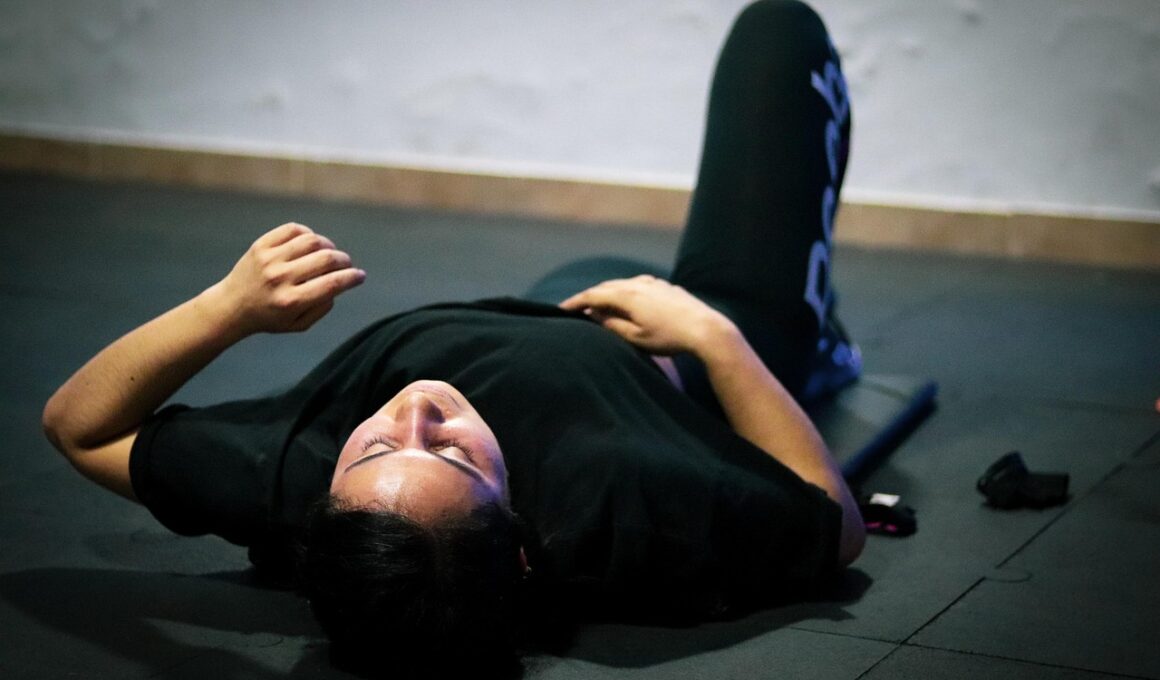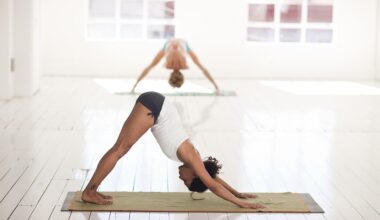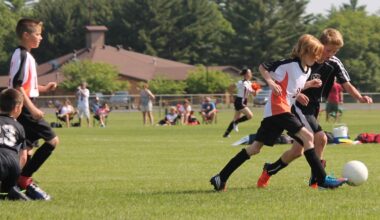Core Training Missteps That Could Be Hurting Your Performance
When engaging in core training, many individuals unknowingly fall into common pitfalls that can hinder their progress. A prevalent mistake is failing to activate the core muscles effectively. The core encompasses a range of muscles, and neglecting certain aspects can lead to imbalances and decreased performance. Another issue is overemphasizing certain exercises, often leading to overtraining specific muscle groups while ignoring others. This can create muscular imbalances and even result in injury over time. A critical element is understanding proper form; without it, efficacy diminishes significantly. Stressing other muscles instead of the core defeats the purpose of these exercises. Additionally, many individuals have a tendency to rush through their routines, which can lead to poor technique. Quality is infinitely more important than quantity during core workouts. Rest periods are also crucial yet often overlooked; inadequate recovery can impair muscle repair and growth. Lastly, neglecting flexibility and mobility work negatively impacts the core’s overall performance. Core stability and strength should be complemented by flexibility to ensure a balanced workout routine. By avoiding these common mistakes, individuals can optimize their core training effectively.
Neglecting Breathing Techniques
Breathing properly during core exercises is essential for maximizing performance and effectiveness. Many trainees overlook this vital component, relying on instinct rather than a conscious strategy. Incorrect breathing patterns can lead to reduced muscle activation and potential injury. For instance, many people hold their breath during key lifts or exercises, which decreases stability and oxygen supply. This can lead not only to fatigue but also to compromising performance. Implementing appropriate breathing techniques can increase the efficiency of movements when performing exercises like planks or crunches. Exhaling during the exertion phase helps maintain internal pressure within the core, supporting stability. Conversely, inhaling during the relaxation phase allows for enhanced oxygenation of the muscles. Additionally, both strategies can improve engagement of the transverse abdominis, core stability, and overall strength. Furthermore, understanding how to incorporate diaphragm breathing strengthens the core more effectively. This technique promotes better intra-abdominal pressure management, enhancing performance. Ultimately, always being mindful of your breathing while training can elevate your routine significantly. Dedicating time to practice these techniques ensures long-term success in core training.
Another frequent misstep is ignoring the significance of variety in core workouts. Sticking to the same routine can lead to monotonous workouts and diminish overall results. Incorporating different exercises can target muscles from various angles, promoting a well-rounded approach. For instance, incorporating rotational movements adds an additional layer of challenge, enhancing overall core stability. Many trainers recommend including exercises such as Russian twists and bicycle crunches to diversify routines. Furthermore, using different equipment, such as stability balls or resistance bands, can increase engagement and fun in workouts. This not only helps prevent boredom but also encourages consistent training adherence. Moreover, varying rep ranges and volumes will help adapt muscles to new stimuli, leading to growth and endurance improvements. Failing to progress by continually challenging yourself can stall your results and motivation. Evaluating your workout every few weeks can help create a more effective training plan, ensuring continual engagement and progress in your core training. Therefore, aim to incorporate a broader spectrum of exercises to achieve optimal core performance over time. By diversifying your core routine, over time, enduring results will follow.
Ignoring Recovery and Rest
In the world of fitness, the focus generally is on hard work, often leading individuals to overlook the importance of recovery. Recovery is crucial for muscle growth and repair, specifically when training the core. Without adequate rest, muscles do not have the opportunity to recuperate fully and strengthen, leading to diminished performance. Overtraining can also increase the chance of injuries, leaving individuals frustrated and unable to perform at their best. A crucial method to ensure recovery involves implementing recovery days between intensive core workouts. Utilizing these days allows muscles to repair and grow stronger. Additionally, practicing techniques such as foam rolling or light stretching can enhance blood flow and alleviate tightness. Also, nutrition plays a pivotal role in muscle recovery and performance levels, as it fuels the body and aids in injury prevention. Incorporating post-workout protein shakes or essential nutrients can significantly enhance recovery journeys. Ignoring recovery days will negatively impact strength, endurance, and overall core health. Therefore, understanding and respecting the balance between hard work and recovery is essential for long-term success in your core training program.
Another common mistake is neglecting the importance of functional core training. Individuals often limit their exercises to traditional movements like crunches, which do not mimic natural patterns of daily activities or sports. Maintaining a functional approach ensures that core exercises improve overall performance during real-life activities. Incorporating exercises like deadlifts, squats, and overhead presses engages the core effectively while also strengthening other muscle groups. This cross-training strategy promotes holistic training that enhances overall strength and coordination. By incorporating bodyweight movements like planks and stability ball exercises, individuals gain multi-dimensional benefits that challenge the core dynamically. The goal is to prepare the body for various movements rather than isolating core strength solely. This functional training aspect makes exercising more applicable and improvements noticeable in everyday situations like lifting objects or maintaining balance while walking. Enhancing core strength improves agility, reduces injury risks, and enhances overall athletic performance. Therefore, focusing on functional core workouts will produce better results than simply performing aesthetically pleasing isolation exercises. Emphasizing functional training is paramount for maintaining practical fitness levels and overall well-being.
Relying Exclusively on Equipment
Many individuals assume that core training necessitates expensive equipment or gym memberships for effectiveness. However, that’s a common misconception surrounding core training’s efficacy. Many effective exercises can be performed without any equipment, relying on body weight alone. Movements like planks, bridges, and side planks provide excellent core engagement while being easily accessible. Building core strength doesn’t require fancy machines or overwhelming equipment—simplicity often yields remarkable results. Utilizing these fundamental exercises can create a strong foundation for building upon as one progresses. Additionally, stepping away from equipment reduces dependence and resistance offers, allowing enhanced focus on body mechanics. Regularly incorporating varied body weight exercises also brings awareness to proper form and core engagement. Elite athletes often integrate bodyweight movements into their routines for effective training, highlighting their importance for fitness regimens. Furthermore, performing movements without equipment often enhances one’s functional strength and stability. By indulging in body weight exercises consistently, individuals can improve their core’s efficacy and resilience. Therefore, embracing a diverse approach—both bodyweight and equipment—maximally benefits long-term development of core strength.
A significant mistake involves disregarding the role of endurance in core training. Focusing exclusively on strength can lead to imbalances that impact overall core performance. Core endurance is vital as it enables muscles to sustain prolonged activities and maintain stability during various exercises. Core exercises, such as holds and planks, train not just strength but also endurance. Enhancing endurance will allow core muscles to better support the spine throughout daily activities or workouts. Including longer-duration holds at a lower intensity ensures comprehensive development engaging different muscle fibers. Gradually increasing the durations of these holds challenges adaptations improving endurance over time. It is also crucial to balance high-rep endurance work with lower-rep strength training to maximize results. Most importantly, listening to the body’s signals throughout this progression phase ensures appropriate growth without overstressing the muscles involved. Incorporating endurance training leads to improved posture and stability, positively affecting athletic performance. By taking the time to build both strength and endurance within core training, individuals can achieve optimized results that enhance performance in numerous physical endeavors. Integrating these essential components will ultimately transform any fitness routine.
Conclusion
In conclusion, recognizing and correcting mistakes within core training is key to optimizing performance. Awareness of common pitfalls allows individuals to enhance effectiveness in their workout regimens significantly. Avoiding errors such as neglecting proper breathing techniques, overtraining, and failure to respect recovery periods leads to a more robust fitness foundation. Prioritizing functional movements, resistance, body weight exercises, and core endurance benefits overall health. Further, integrating proper variety helps maintain motivation and enhances engagement, producing even better results. Avoid dependence solely on equipment, as embracing diversity in your routine fosters creativity and efficiency. As you progress, revisit and revamp your strategies based on your evolving fitness levels and goals. Patience in core training is invaluable, and understanding the need for balance throughout these programs is vital. Ultimately, making these adjustments will not only bolster your core strength, but also valuable lessons in overall fitness will be learned. Striving for continuous improvement will ultimately reward your efforts and further enhance your core capabilities in conjunction with athletic endeavors.





